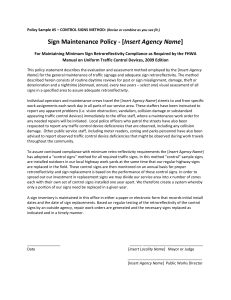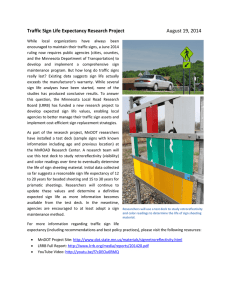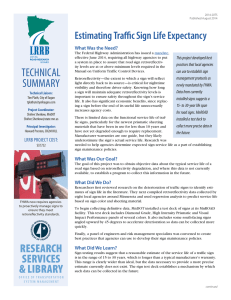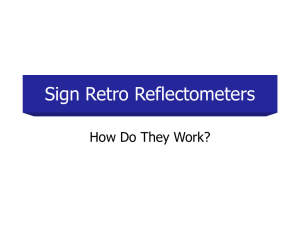Assessment of Sign Retroreflectivity Compliance for
advertisement
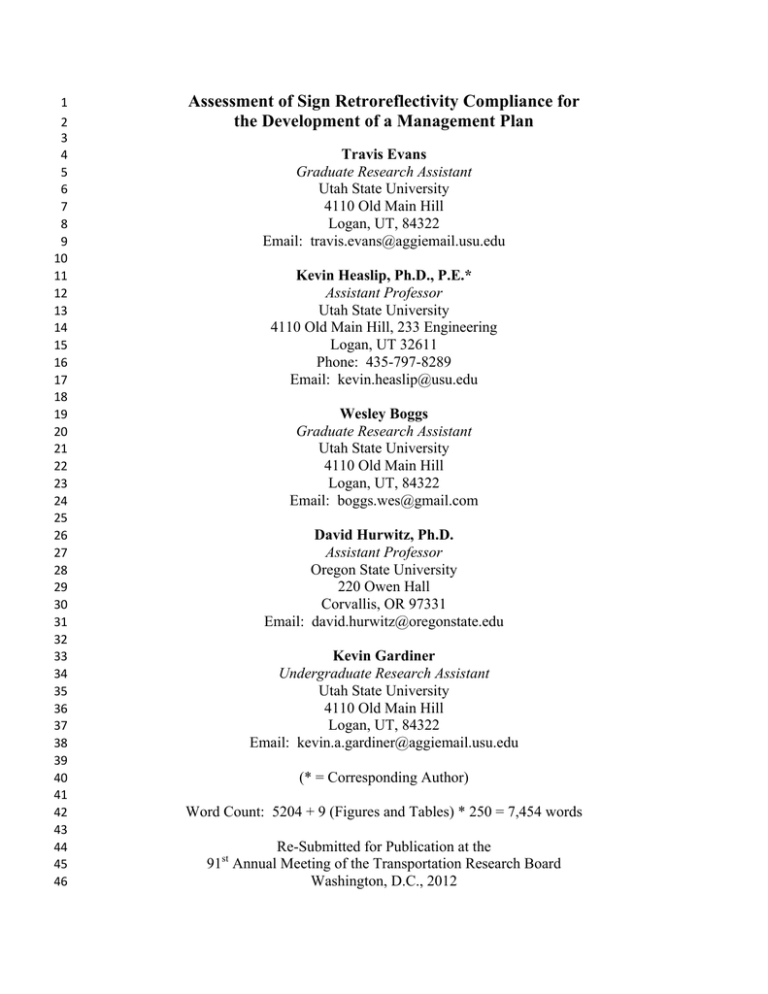
1 2 3 4 5 6 7 8 9 10 11 12 13 14 15 16 17 18 19 20 21 22 23 24 25 26 27 28 29 30 31 32 33 34 35 36 37 38 39 40 41 42 43 44 45 46 Assessment of Sign Retroreflectivity Compliance for the Development of a Management Plan Travis Evans Graduate Research Assistant Utah State University 4110 Old Main Hill Logan, UT, 84322 Email: travis.evans@aggiemail.usu.edu Kevin Heaslip, Ph.D., P.E.* Assistant Professor Utah State University 4110 Old Main Hill, 233 Engineering Logan, UT 32611 Phone: 435-797-8289 Email: kevin.heaslip@usu.edu Wesley Boggs Graduate Research Assistant Utah State University 4110 Old Main Hill Logan, UT, 84322 Email: boggs.wes@gmail.com David Hurwitz, Ph.D. Assistant Professor Oregon State University 220 Owen Hall Corvallis, OR 97331 Email: david.hurwitz@oregonstate.edu Kevin Gardiner Undergraduate Research Assistant Utah State University 4110 Old Main Hill Logan, UT, 84322 Email: kevin.a.gardiner@aggiemail.usu.edu (* = Corresponding Author) Word Count: 5204 + 9 (Figures and Tables) * 250 = 7,454 words Re-Submitted for Publication at the 91 Annual Meeting of the Transportation Research Board Washington, D.C., 2012 st Evans, Heaslip, Boggs, Hurwitz, & Gardiner 1 2 3 4 5 6 7 8 9 10 11 12 13 14 15 16 17 18 19 20 21 22 23 24 25 26 27 28 29 30 31 32 33 34 35 36 37 38 39 40 41 42 43 44 45 46 2 ABSTRACT The Manual on Uniform Traffic Control Devices (MUTCD) specifies minimum retroreflectivity requirements that include an obligation for agencies to develop a strategy for maintaining compliance. States were given a deadline of January 1, 2012 for the implementation of an assessment or management plan, which led to an increased emphasis on sign asset management. However, a new rule was submitted to the federal register to extend and modify the deadlines. With budget considerations it is important that a transportation agency implement an assessment or management plan that is efficient and provides compliance with the standards required by the Manual on Uniform Traffic Control Devices (MUTCD). The development of an efficient plan requires knowledge of the overall condition of an agency's assets as well as unique considerations regarding their performance. Through a review of previous data collection efforts, this paper details the development of a data collection strategy for assessing the performance of traffic signs maintained by the Utah Department of Transportation (UDOT). Agency operations, site selection, and attribute collection were all considered while developing a collection plan for an agency where limited inventory and installation data was available. Retroreflectivity measurements were taken for 1,433 UDOT signs. This sample provided a snapshot of current compliance and assisted in the selection of an asset management plan for maintaining sign retroreflectivity. Results from the study showed that UDOT’s signs were well over 90% compliant to the MUTCD standards and preliminary management strategies were presented to address vandalism and other damage. INTRODUCTION Establishing standards for minimum levels of retroreflectivity for traffic signs was first directed by the Congress to the Secretary of Transportation in 1992. This congressional mandate established the foundation for the adoption of new language into the second addition of the 2003 Manual for Uniform Traffic Control Devices (MUTCD). The necessity for a sign management program comes from the necessity to comply with the MUTCD standards, as well as a need to efficiently allocate maintenance funds. The MUTCD currently contains the mandate that by the year 2012 "Public agencies or officials having jurisdiction shall use an assessment or management method that is designed to maintain retroreflectivity" (1) at a level that is at or above the minimum retroreflectivity levels that are provided. However, a new rule has been proposed to modify the current retroreflectivity regulations. As guidance, the MUTCD provides six assessment and management methods for complying with this mandate. These methods are: A. Visual Nighttime Inspection B. Measured Sign Retroreflectivity C. Expected Sign Life D. Blanket Replacement E. Control Signs Methods A and B are classified as assessment methods and methods C, D, and E are classified as management methods for complying with the minimum retroreflectivity level standards. Each assessment or management method is designed to maintain the minimum retroreflectivity levels shown in Table 1. Agencies are required to ensure that all traffic signs in their jurisdiction that are not explicitly excluded in the MUTCD be in compliance with these standards. Currently the signs Evans, Heaslip, Boggs, Hurwitz, & Gardiner 1 2 3 4 5 6 7 8 9 10 11 12 13 14 15 16 17 18 19 20 21 22 23 24 25 3 must be compliant by the year 2015 for regulatory, warning, or post-mounted guide signs and the year 2018 for street sign names and overhead guide signs although. At this time, it has been proposed that the MUTCD be amended to remove these compliance dates, but the minimum levels to be maintained are to remain for regulatory and warning signs. With budget considerations and constraints, it is important that transportation agencies select a management or assessment method that will best meet the agencies compliance needs, while doing so in the most efficient manner possible. Each individual method requires varying types and degrees of agency resources and carries their individual costs in ensuring an acceptable degree of overall compliance. TABLE 1: Minimum Retroreflectivity Levels Selecting an appropriate management or assessment method to efficiently maintain sign retroreflectivity requires an understanding of the conditions and factors unique to a particular agency. Additionally, it is important to understand the degree of current overall compliance with minimum standards when establishing policy to manage any of an agency's assets. In order to facilitate this, it is imperative that agencies collect information regarding the state and condition of their assets. The objective of this research is to provide a data collection and analysis procedure that will assist in the development a sign asset management strategy to comply with the minimum retroreflectivity levels stipulated in the MUTCD. The purpose of data collection is to provide a quantitative assessment of overall compliance with minimum retroreflectivity levels, which will give guidance in the selection of a management method to ensure future compliance. The data collected is analyzed to provide insight regarding the current state, performance, and special Evans, Heaslip, Boggs, Hurwitz, & Gardiner 1 2 3 4 5 6 7 8 9 10 11 12 13 14 15 16 17 18 19 20 21 22 23 24 25 26 27 28 29 30 31 32 33 34 35 36 37 38 39 40 41 42 43 44 45 46 4 considerations relating to the Utah Department of Transportation's (UDOT) sign assets. This paper provides detail of the data collection effort, analysis of the collected data, and then shows how the data collected influenced the sign management strategy for UDOT. BACKGROUND Each assessment or management method requires some degree of understanding of an agencies sign assets and how they are performing over time. Beyond just meeting the minimum retroreflectivity conformance criteria, sheeting performance, damage rates, maintenance, and overall visibility should all be considered when developing a sign asset management program. In the past, the majority of data collection efforts for the retroreflectivity of traffic signs have been focused upon understanding how the retroreflectivity of traffic signs deteriorates (2) (3) (4). For development of an asset management strategy to comply with the then proposed minimum levels of retroreflectivity of signs in North Carolina, a study was performed that reviewed various approaches to managing retroreflectivity (5). The work focused on the collection of retroreflectivity data and its use in the evaluation of the effectiveness of current inspection methods as well as the potentials of implementing various management strategies. The field data collection portion of the project was concerned with field inventories and compliance as well as the effectiveness of various methods of maintaining retroreflectivity. Collecting data with this focus provided a framework for which cost analyses and operational performance may be evaluated. Research performed for the Louisiana Department of Transportation & Development evaluated data collection procedures with respect to the use of computer based technologies including GIS, GPS and inventory equipment. (6) Key attributes were collected in order to allow for assessment of the possibility of performing larger scale inventories. The collection area was selected for its widely varied functional road classification as well as a variation of in the commercialization of its regions. The data collection procedure was designed to provide a basis for future analyses and to assist in future decision making. There have been various other data collection efforts where the data collection methodology was explicitly designed in order to achieve specific goals. These goals range from assisting with the management of retroreflectivity, to modeling the deterioration of retroreflectivity over time. Researchers at Purdue University collected retroreflectivity measurements for 800 Type I and Type III signs where sign age was known over a 20-year period. The data was collected for the development of survival curves for Type I and Type III sheeting. The resulting curves were to assist in determining replacement costs and assessment cycles when managing the retroreflectivity of traffic signs. The results were limited though, as not all Type I and Type III sheeting is alike and cannot be combined for failure prediction. (7) In studying in-service Type III high intensity traffic signs in Texas, researchers developed a collection plan that included sampling procedures to account for sign densities and varying site conditions. (8) The collection focused on regional areas that displayed distinctive characteristics. This study did not provide a data collection procedure to assess overall conformance with minimum standards. However, such targeted attribute collection will provide a basis to evaluate special considerations relevant to an agency’s assets. Pierce County in Washington State found that a sign inventory that included retroreflectivity measurements proved useful in assisting with the selection of a sign management strategy. (9) The county found that the data collected was beneficial for managing their traffic signs. Additionally their inventory provided an approximation of the control group Evans, Heaslip, Boggs, Hurwitz, & Gardiner 1 2 3 4 5 6 7 8 9 10 11 12 13 14 15 16 17 18 19 20 21 22 23 24 25 26 27 28 29 30 31 32 33 34 35 36 37 38 39 40 41 42 43 44 45 5 size needed to maintain a desired degree of reliability in estimating the representation of the overall population. For other agencies retroreflectivity measurements have been found instrumental in assisting to evaluating compliance with required minimum standards. (10) Such an inventory provides significant assistance in identifying issues with the performance of assets currently in use. The collection of field data is the first step in the development of an efficient management plan. Past experience has proven that the proper selection of samples, procedural methodology, and attribute collection is crucial when trying to identify performance and compliance issues within an agency’s assets. Great care must be taken in the development of a data collection procedure to ensure that potential issues may easily be identified and that results of the collection may be utilized for planning and policy making. DATA COLLECTION METHODOLOGY The necessity for a sign management program comes from the need to comply with the MUTCD standards and by necessity. Increasingly limited budgets and resources provide challenges for state DOTs to allocate their maintenance funds efficiently. The allocation of limited resources must be based on the analysis of various options and tradeoffs and decisions must be made with quality information (11). In order to develop a data collection plan that facilitates a transportation agency’s need to efficiently manage assets, special consideration must be taken when developing a data collection strategy. The purpose of data collection is to provide a quantitative assessment of overall compliance with minimum retroreflectivity levels, which will give guidance in the selection of a management method to ensure future compliance. When developing the data collection procedure it is important to include considerations that can directly affect the selection, methodology, and procedure of a particular plan. These considerations include: agency operations, site selection, sign attribute selection, and procedural methodology. Agency Operations Understanding the operational procedures of an agency is instrumental for evaluating the feasibility of asset management options as well as providing a context for data collection. Using prior inventory efforts and understanding data management procedures within UDOT provided key information for developing a collection strategy. Recent efforts by UDOT in developing a central database for transportation assets proved beneficial. The database provided information including an inventory of sign retroreflectivity conducted between 1999 and 2001. Site Selection Collection sites were selected to be representative of signs within the state to provide an overall snapshot of compliance and conditions present within different geographic areas. It is critical that the sample provide the best representation possible of the overall population given the resources available. The structure of UDOT consists of four administrative regions. Each region is subdivided into maintenance stations where maintenance is overseen at the local level. In Utah, maintenance strategies are directed and overseen at the region level. As noted in the Texas study (8), there can be difficulty in establishing a sample set that is truly representative of the overall condition of signs as sign densities vary greatly and costs must be considered when establishing a sample set. In the case of UDOT with maintenance efforts Evans, Heaslip, Boggs, Hurwitz, & Gardiner 1 2 3 4 5 6 7 8 9 10 11 12 13 14 15 16 17 18 19 20 21 22 23 24 25 26 27 28 29 30 31 32 33 34 35 36 37 38 39 40 6 varying greatly by region and individual maintenance sheds it was important to provide a representative sample. To establish an overall sample, sign data was collected for locations that were representative of each region. From reviewing previous inventory efforts within the state, junction areas between state routes were identified as containing among the highest densities of traffic signs. For this reason routes were selected that had a high junction density. Along with the high sign density, junctions also contained a wide variety of sign color. To better represent the variation of maintenance and construction activities between stations and regions on highway segments, signs of every color were collected in intervals of five to fifteen miles. The survey team, who based the decision on sign density and geographic conditions present along the route, determined the intervals. Because canyon routes represent unique situations in Utah and contained high densities of signs, data was collected every five miles whereas data on rural roads were collected every fifteen miles. These intervals were used to provide an adequate representation of the overall sign population. Sign Attribute Selection To analyze and determine special considerations unique to Utah with regards to sign asset management, specific attribute data was collected for signs. All data was recorded with a hand held GPS unit that included a customized data dictionary to enter information. Attributes recorded in the hand held GPS unit included background color, sheeting type, retroreflectivity measurements, orientation, mount height, offset, installation date, and major and minor damage. Identification of sheeting types was accomplished by applying the Federal Highway Administrations identification guide (12). Retroreflectivity measurements were taken with the use of a Delta RetroSign Model 4500 retroreflectometer. The Model 4500 illuminates the sign at a -4° angle with the angle of observation being 0.2°. In addition to recording information in the hand held GPS unit photographs were taken of every surveyed sign and linked to the data to further classify any damage or vandalism. In order to classify damage issues of the signs and the associated effects on retroreflectivity five damage categories, shown in FIGURE 1, were used during the collection process. Damage categories included bending, peeling, vandalism, cracking, and other. These categories are defined as follows: • Bending damage describes signs that had significant portions of the sheeting bent causing light to be reflected away from its origin. • Peeling damage applies to the legend of a sign peeling off of the background sheeting. • Vandalism is the most diverse category of damage and included damage caused by paintballs, bullet holes, beer bottle impacts, stickers, and graffiti. • Cracking damage was only present upon Type I sheeting signs and consisted of the retroreflective background cracking and degrading over time. • Other forms of damage recorded were fading, tree rubbing, and tree sap. Evans, Heaslip, Boggs, Hurwitz, & Gardiner 1 2 3 FIGURE 1 Damage Categories. 7 Evans, Heaslip, Boggs, Hurwitz, & Gardiner 1 2 3 4 5 6 7 8 9 10 11 12 13 14 15 16 17 18 19 20 21 22 23 24 25 26 27 28 29 30 31 32 33 34 35 36 37 38 39 8 Installation Data Because of the limited installation data, additional effort was taken to collect sign data where installation information was known. Since 2008, UDOT has mandated that all signs placed into the field have an installation sticker on both the front and back of the sign. Typically the sticker on the front of the sign has a transparent background with a black legend for the year it was installed, whereas the back contains the month and year of installation and the company that constructed the sign. Although mandatory since 2008, compliance with this policy was not consistently adopted by the stations and contractors installing signs for UDOT. Collection Procedure After a few preliminary trails it was determined that the data collection would be performed by a three-man team to increase safety and efficiency of the data collection process. For increased efficiency each man would have specific task to complete for the various sign attributes. Researcher one was the driver of the vehicle and was in charge of loading and unloading the ladder as well as taking retroreflectivity measurements. Researcher two was the front seat passenger and was in charge of entering data into the hand held GPS unit. Researcher three was in charge of taking photographs and sign measurements. The sign survey process was broken up into three sequential stages: the (1) setup, (2) measurement, and (3) teardown. As the member of the research team took the retroreflectivity measurements, the other members of the team began to enter attributes of the sign into the GPS unit. Following this survey process the research team was able to measure on average 15 signs per hour, which is comparative to pervious collection projects (5). This average included the time spent traveling between sign locations. In the case of a full sign inventory where sign densities were much higher, this collection rate would likely prove much higher. It is also possible to increase this rate by reducing the number of attribute measurements per sign. DATA ANALYSIS The research team measured a total of 1,433 signs, spanning UDOT’s four regions. The sample size was approximately 1.5% of the 95,000 signs UDOT currently maintains. Expectedly, white and yellow signs make up the majority of the surveyed signs. TABLE 2 displays a summary of surveyed signs divided amongst UDOT's four regions. TABLE 2 Surveyed Sign Summary In accordance with ASTM E1709-09, four measurements for both the retroreflective background and legend, if applicable, were taken for each sign. These four measurements were averaged in order to determine the signs overall retroreflectivity per the ASTM standard. During the measurement of each sign, special considerations were taken to ensure that the Evans, Heaslip, Boggs, Hurwitz, & Gardiner 1 2 3 4 5 6 7 8 9 10 11 12 13 14 15 16 17 18 19 20 21 22 9 retroreflectometer was held vertical and steady against the sheeting as well as taking measurements at the same four areas regardless of sign damage. FIGURE 2 displays box-andwhisker plots for each sign type collected across all four UDOT regions. The vertical lines that traverse the plots are the minimum retroreflectivity levels for each sheeting background type and color. MUTCD Compliance One goal of this research was to take UDOT's limited sign inventory and installation data and assess the current compliance rate for the new MUTCDs minimum retroreflectivity levels. For the compliance rates presented within this research signs were only rejected if the retroreflectivity was below minimum retroreflectivity levels. Though damage was reported and categorized, a sign was never rejected purely based on damage alone. TABLE 3 displays the compliance rate for the surveyed signs by sheeting type and color. TABLE 3 Compliance Summaries The vast majority of all rejected signs were Type I and Type III. Although there were seven rejections of Type IX sheeting, all of which were green, five were caused by legend retroreflectivity and the remaining two were caused by special causes. For the six rejected red signs, one was a stop sign and the remaining five were exclusion signs. For the overall sign sample population the failure rate was 9 % Evans, Heaslip, Boggs, Hurwitz, & Gardiner 1 2 FIGURE 2 – Retroreflectivity Box-and-Whisker Plots by Sheeting Type and Color 10 Evans, Heaslip, Boggs, Hurwitz, & Gardiner 1 2 3 4 5 6 7 8 9 10 11 12 13 14 15 16 17 18 19 20 21 22 23 24 25 26 27 28 29 30 31 32 33 34 35 36 37 38 39 40 41 42 43 44 45 11 Type I Signs UDOT began phasing out the use of Type I sheeting due to its low levels of retroreflectance and corresponding short service life. At the completion of the survey period there was no Type I red sheeting signs surveyed. Comparing this to a retroreflectivity study conducted in 1999 where in Region 1 and Region 3 there were 177 red signs in service shows the concerted effort by UDOT to remove Type 1 signs. The mean retroreflectivity level for Type I signs in the surveyed sample set was 36 (cd/lx/m2) which is well below the minimum level of 50 (cd/lx/m2). Sixty percent of all Type I whites failed, which is triple the rate calculated from measurements taken in the 1999 study. White Type I signs had the high rate of cracking damage which is likely the root cause for the increase in failures. Although the majority of Type I white signs are most often non-compliant, there are a few examples that are still perform well. In the surveyed sample population Type I white were usually used for route identifications and speed limit signs. Yellow Type I had the highest failure rate of any Type I sign color with 80% have retroreflective measurements below the minimum levels. This is an increase in the 77% failure determined from the 1999 retroreflectivity study. Yellow Type I had the high rate of vandalism and had mean retroreflective at a third of the minimum level. Green backgrounds made up the smallest percentage of Type I sheeting with only 15 being measured during the sign survey. Similar to the other Type I background colors, Green had a mean measurement, of 4 cd/lx/m2, that is below the minimum retroreflective level. Of the survey sample 75% of them measured below the minimum level. Type III Signs The UDOT Type III signs were performing rather well with only three percent failing. Values for Type III red ranged from a value of 12 to 91 cd/lx/m2 with a mean of 38 and a standard deviation of 21. Of 111 signs collected there were only 6 failures. The failures were all old sheeting where visible damage and fading was present. Of 204 Type III green measured only 2 signs were found to be failing. Values measured ranged from 19 to 73 cd/lx/m2 with a mean of and standard deviation of 9 cd/lx/m2. Very few issues were found with the Type III green population where the only exceptions being signs that exhibited extreme fading and cracking. The Type III yellow sample set contained the highest degree of variability with measured values ranging from 5 to 394 cd/lx/m2. The mean measurement of the Type III yellow signs was 194 and the standard deviation 72. The majority of failed signs exhibited either extreme damage, weathering, or vandalism was present. Of all signs evaluated yellow sheeting was roughly three times more likely to display vandalism than any other sheeting. Damage was often visible from bullet holes, paintballs, and damage from projectiles thrown from vehicles such as glass bottles. From the samples collected there were no Type III white sheeting failures. Observed values ranged from 91 to 394 cd/lx/m2 with a mean 275 cd/lx/m2 of and standard deviation of 36 cd/lx/m2. The Type III population is performing extremely well with respect to compliance with the majority of signs well above the minimum required standards. The Type III HIP population, though small, was performing very well within the state. Type III red values ranged from 15 to 225 cd/lx/m2 with mean of 122 and a standard deviation of 52.7. White values ranged between 270 to 890 cd/lx/m2with a mean of 646.8 and standard deviation of 142.4. Yellow values ranged between 189 to 627 cd/lx/m2 with a mean of 434.6 and Evans, Heaslip, Boggs, Hurwitz, & Gardiner 1 2 3 4 5 6 7 8 9 10 11 12 13 14 15 16 17 18 19 20 21 22 23 24 standard deviation of 86. Green values ranged between 47 to 141 cd/lx/m2 101.2 and a standard deviation of 20.3. 12 with a mean of Type IX and XI Signs Type IX and Type XI are the newest sheeting in UDOT's overall sign population. Aside from a few exceptions with Type IX Green sheeting, the Type IX and Type XI sheeting were performing well beyond the minimum required levels. The mean and standard deviation for Type IX green was observed at 72.6 and 29.79 cd/lx/m2 respectively. The green Type IX signs that exhibited low values were a result of a construction issue where Type IX green sheeting was overlaid upon Type IX white with the legend being cut from the green overlay. Signs with this construction exhibited extreme peeling problems and low retroreflectivity values in relatively new signs. There were no failures recorded for signs with red, white or yellow backgrounds for either Type IX or Type XI. The values for these sheeting types did vary greatly within sample populations. Prismatic Sheeting Variance When collecting the sample sign data, inspectors noted a great degree in variation in the measurement of many recently placed traffic signs that utilized prismatic sheeting. This tremendous variation was evident when reviewing the plots for signs where installation dates where known. Because the tracking of sign installation data is a relatively new procedure for UDOT and has taken some time for implementation, the samples with known sign installation data was fairly low. Despite the small data set with known installation dates, an extreme degree of variation is clearly evident in signs that were recently placed as seen in FIGURE 3. These measurements were for signs that did not display signs of damage. Evans, Heaslip, Boggs, Hurwitz, & Gardiner 1 2 3 4 5 6 7 13 FIGURE 3 Retroreflectivity measurements of prismatic sheeting with installation dates. The greatest ranges of measurements were seen in Type IX, Type XI, and signs with white and yellow backgrounds. TABLE 4 provides an example of the range of values of measurements recorded by researchers for Type IX and Type XI signs that were placed within one year of inspection and had no visible damage or weathering. Evans, Heaslip, Boggs, Hurwitz, & Gardiner 14 1 TABLE 4 Type IX and Type XI Placed Within 1 Year. 2 3 4 5 6 7 8 9 10 11 12 13 14 15 16 17 18 19 20 Further evaluation of these signs identified a possible explanation to this variation regarding an issue of inefficiency with the construction of many of UDOT's newly placed traffic signs. The problem identified relates to the rotational sensitivity of the sheeting used for a large majority of signs placed within recent years. While the sheeting utilized by UDOT for many of their new signs is designed to be usable at any orientation, due to the utilization of cube corner retroreflection the sheeting is most effective when placed at a specific orientation. The range of values measured varies greatly depending on the orientation with which the sheeting was placed with much sheeting not being placed at the optimal orientation. This issue was discovered primarily for Type III HIP, Type IX, and Type XI Sheeting where signs throughout the state were discovered that the sheeting was oriented at varying degrees. This issue is further exaggerated when measurements are taken with a point retroreflectometer. FIGURE 4 shows an example of the range of values possible from sign construction with sheeting in varying conditions when sign sheeting is placed at varying orientations. The measurements were taken from three types of white sheeting currently being used by UDOT. FIGURE 4 also shows the signs at 0 and 90 degree orientations. With the sheeting on these signs it can be determined by orientation of the pattern seen in the white background. 21 22 FIGURE 4 Rotational Sensitivity Example Evans, Heaslip, Boggs, Hurwitz, & Gardiner 1 2 3 4 5 6 7 8 9 10 11 12 13 14 15 16 17 18 19 20 21 22 23 24 25 26 27 28 29 30 15 Similar distributions were found for other Type IX and Type XI sheeting currently being utilized by UDOT. Sheeting placement in varying orientations was found for all background color types. The majority of yellow signs constructed of any type of prismatic sheeting within UDOT were discovered to be placed at an orientation less then optimal. Damage and weathering are of particular concern in the development of an asset management strategy to maintain compliant with minimum retroreflectivity requirements. Even small amounts of damage that is visible during the daytime can have a large effect upon the signs ability to convey messages under nighttime conditions. The overall percentage of damaged signs varied greatly by region and environment. Damage was classified as either being major or minor dependent upon the overall effect of the message of the sign. Major damage included any degree of damage on the sign face that affected the legibility of the sign. TABLE 5 summarizes damage rates throughout UDOTs regions. TABLE 5 Damage Rates by Region and Color Conclusion With deadlines approaching for compliance with the MUTCD retroreflectivity requirements, this research was intended to provide a data collection strategy to assist with state DOT planning and policy development. With budgetary constraints it is imperative to utilize a strategy that will provide both efficiency and compliance. In order to develop an efficient asset management strategy there must be an understanding into how a particular agency's assets are performing and what conditions are present that are affecting the overall performance and life of the assets. For this reason particular emphasis is given on the procedure and methodology used when collecting data for this purpose. It is important to gather the necessary information in a manner that provides an overall representation of the agency's assets. Previous experience informed the data collection strategy of this project and the experiences of the research team helped inform the future data collection procedures as well as the ability to highlight previously unknown issues to UDOT, such as the rotational sensitivity of the signs. Many unique conditions and situations that directly affected traffic sign management Evans, Heaslip, Boggs, Hurwitz, & Gardiner 1 2 3 4 5 6 7 8 9 10 11 12 13 14 15 16 17 18 19 20 21 22 23 24 25 26 27 28 16 were found though the data collection procedure. As these considerations were identified and incorporated into the process the continuing insight provided for a better overall understanding of how the sign assets were performing. Overall the sample sign survey provided a valuable assessment of overall compliance with the MUTCD minimum retroreflectivity requirements. Reviewing the data also identified issues with UDOT's sign construction and management that were previously unseen. Utilizing a methodology that included the collection of sign and sight condition attributes provided the information necessary to develop a retroreflectivity management plan that considers UDOT's own assets and the most economical and feasible steps to ensure compliance. Outside of Type I sheeting used by the state, the majority of UDOT's assets are currently in compliance with the new MUTCD standards (91%). With the complete removal of Type I signs the percentage of compliant signs would increase to 97%. The data collected throughout the state, and the results from analysis of the data from this project, may now be used in the development of the plan. The high percentages of damaged signs found, as well as limited installation and service life performance data currently available to UDOT, indicate that an assessment method, either visually or through measurements, will best serve for maintaining retroreflectivity compliance until further information is available. The compliance rates of various sheeting types provided for quick assessments of alternatives for bringing the DOT's current assets up into compliance with MUTCD standards. Given the high failure rate of Type I signs within the state, an initial blanket replacement of all Type I signs and tracking the performance of the replacements would be very beneficial. The data collected also provides for operational changes that has potential of bringing greater efficiency and performance of UDOT’s assets. By carefully planning the collection procedure, a better overall understanding of the materials and maintenance practices between maintenance stations and between regional oversight. Dividing collection proceedings in this manner allowed for better understanding and facilitated data collection that better represented the overall population. This information will be used to develop plans for the maintenance and coordinated replacement of signs for the state. Evans, Heaslip, Boggs, Hurwitz, & Gardiner 1 3 17 BIBLIOGRAPHY 1. FHWA. Manual on Uniform Traffic Control Devices for Streets and Highways. December 2009. 2. Kirk, A. R., E. A. Hunt, and E. W. Brooks. Factors Affecting Sign Retroreflfectivity. Oregon Department of Transportation, Salem, OR-RD-01-09, 2001. 3. Bischoff, A., and D. Bullock. Sign Retroreflectivity Study. Purdue University, West Lafayette, FHWA/IN/JTRP-2002/22, 2002. 4. Immaneni, V. P.K., J. I. Hummer, W. J. Rasdorf, E. A. Harris, and C. Yeom. Synthesis of Sign Deterioration Rates. North Carolina State University, Raleigh, Journal of Transportation Engineering 2009. 5. Vereen, S. C., J. E. Hummer, and W. J. Rasdorf. A Sign Inventory Study to Assess and Control Liability and Cost. North Carolina State University, Raleigh, NC, FHWA/NC/2002017, 2002. 6. Wolshon, B. Louisiana Traffic Sign Inventory and Management System. Louisiana State University, Baton Rouge, Report No. 381, 2003. 7. Hulme, E. A., S. M.L. Hubbard, G. D. Farnsworth, A. M. Hainen, S. M. Remias, and D. M. Bullock. An Asset Management Framework for Addressing the New MUTCD Traffic Sign Retroreflectivity Standards. Purdue University, West Lafayette, TRB Paper TRB Paper 110246, 2010. 8. Re, J. M., J. D. Miles, and P. J. Carlson. An Analysis of In-Service Type III High Intensity Traffic Sign Retroreflectivity and Deterioration Rates in Texas. Texas Transportation Institute, College Station, TRB No. 11-2542, 2010. 9. Ellison, J. W. Tapping into the Power of a Traffic Sign Inventory to Meet the New Retroreflectivity Requirements. Institute of Transportation Engineers Compendium of Technical Papers, Vol. 2008 Annual Meeting and Exhibit, 2008. 10. Rogoff, M. J., A. S. Rodriguez, and M. B. McCarthy. Using Retroreflectivity measurments to Assist in the Development of a Local Traffic Sign Management Program. ITE Journal, Vol. 75, no. 10, October 2005, pp. 28-32. 11. Cambridge Systematics, I., I. PB Consult, and T. T. Institute. Performance Measures and Targets for Transportation Asset Management. NCHRP, Washington D. C., NCHRP Report 551, 2006. 12. Federal Highway Administration. 2011 Traffic Sign Retroreflective Sheeting Identification Guide. 2011. http://safety.fhwa.dot.gov/roadway_dept/night_visib/sign_visib/sheetguide/sheetguide.pdf. Accessed March 14, 2011.
